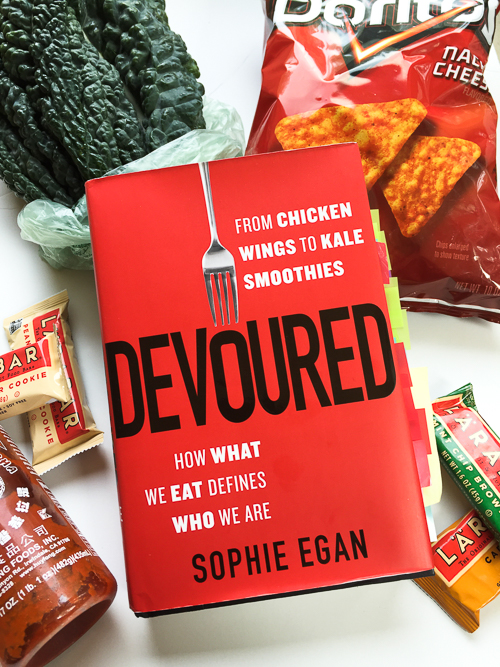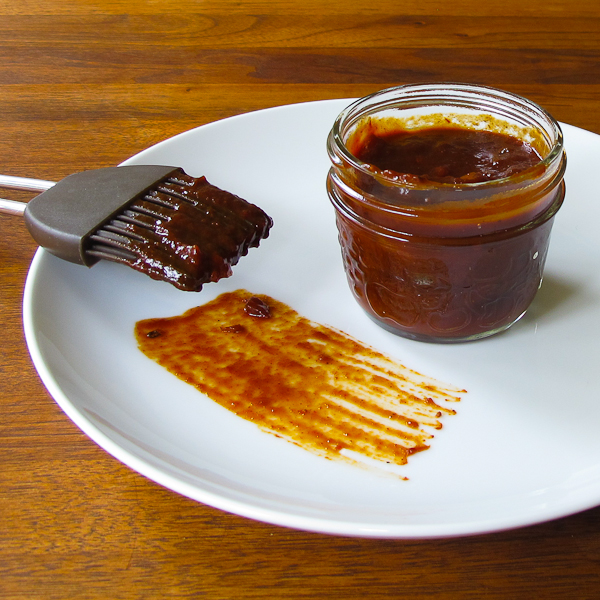— Devoured: From Chicken Wings to Kale Smoothies — How What We Eat Defines Who We Are by Sophie Egan
Sophie Egan’s Devoured is what most food culture books aspire to be: academic yet totally engaging. It’s sociology, marketing, a little psychology and chock full of interesting data and factoids about the what, when and whys of American eating habits.
Whether you approach this book simply as a curious eater or as a student of food marketing, there’s something for everyone in Devoured. If you’re a desk jockey who’s gotten into the habit of the #saddesklunch, or a carb-free/sugar-free/gluten-free/paleo-adherent, or a junk food junkie who ate more than your fair share of the 100 million Doritos Locos Tacos (DLTs) that sold in their first 10 weeks on the market. You’re in here.

I thought about rolling through Taco Bell for a couple of Doritos Locos Tacos for this photo, but hit up my kitchen instead.
The book covers some well-trod territory: American eating habits are informed largely by our propensity to be workaholics, which forces us into eating on-the-go, stuffing our faces with whatever’s easiest during our commutes or while sitting at our desks. Our focus on work and productivity has led to the rise of a gajillion different snack bars, portable soup, 100-calorie packs of cookies and crackers, and even soylent, which sounds like the most joyless edible(?) substance ever.
Then Devoured moves on to the new. At the end of that workweek, we reward ourselves with Sunday brunch – zooming from relative depravation to hollandaise-drenched, oozing egg gluttony. It’s a new day of rest, with time spent waiting in line and working ourselves into a lather over a brunch menu. Is it any coincidence that decadence feels a little like a religious experience after a long week? The Portlandia Brunch Village sketch is funny because it’s true. It’s true!
What’s refreshing is Egan isn’t coming at this from on high, doling out facts, figures and judgment. She’s studied the data, done the interviews, but she’s in this boat with us, and at various points throughout the book she shares personal views and anecdotes that make this book real. She’s breaking out the trail mix in her desk drawer right along with us, rather than going into the kitchen to make a sandwich. We’re all subject to the same forces.
In what might be my favorite chapter in the book, Egan takes on the Age of Stunt Foods – along with those Taco Bell DLTs, think KFC’s Double Down – with an in-depth look into the fascinating world of fast food research and development. It’s no longer driven by just the need to refresh a menu, but by providing shock value in the drive-thru (thanks, social media). And often the process is backward – a stunt food “start[s] with an idea that’s too absurd to ignore – then [companies] use serious science to bring it to life.”
God, this chapter pushes all the right buttons for me. I love me some Doritos, I’ve recreated the Taco Bell bean burrito, and yet I’ve never eaten a DLT or a Double Down. Ugh, that feels a little like the food equivalent of, “We don’t even HAVE a TV.” But as an eater, I was right there on page 241. There are some of us who complement (supplement?) our generally healthy diets with Oreos.
Lest you think it’s all junk food, at the other end of the spectrum are our supposed obsessions with kale and sriracha. As pervasive and mainstream as they seem, the book cites data that more than challenges the perception that kale and sriracha are taking over, but they’re just not. I’ll add riced cauliflower and avocado roses to that list without the data. What you see on TV, on foodie blogs and social media aren’t a microcosm. The real picture is much bigger and more complex.
It’s hard to tackle social media in a book. The realities of publishing timelines can make a text out of date before it even goes to print, but it’s the one area I would have liked to have seen a little more on in Devoured. Aside from being a marketing amplifier for stunt foods, is social media really changing how and what we eat? Are people seeing homemade meals on social media and splitting the difference with meal prep services like Blue Apron? Or is social media just serving as food fantasy and meanwhile, most of us are popping a frozen mac-and-cheese into the microwave or hitting the drive-thru out of convenience?
What I appreciate about Devoured is that there’s some conclusion. Far too often food culture books lay out a bunch of history, some interesting scenarios and factoids and then say, “Thanks, have a nice day.” Devoured gives us a closing chapter on “What to Make of All This.” The answers aren’t definitive, they never are with food, but I like where it ends up, with some suggestions on how to go forward. And I like where I ended up with it.
Devoured has gotten me thinking – about the foods that make us who we are as Americans and as individuals, the shame game we play with ourselves and the aspirational food flags we wave on social media.
Devoured is the kind of book I wish we had when we studied trendspotting in undergrad. Faith Popcorn’s book Clicking, was a sort of futurist’s bible in those days, but had Devoured been around, I might have thought more seriously about pursuing PR for consumer products, rather than tech. Though in this day and age, the idea of promoting the next stunt food (and the next, and the next) is a little daunting.




